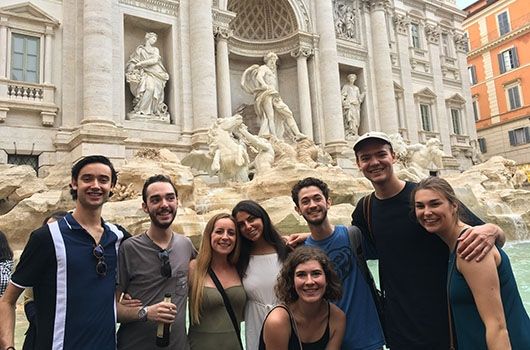The Ultimate Guide to Studying Abroad in Italy
Italy is the top destination for U.S. study abroad students, according to the latest data. You’ll get no argument from us on that. Italy is truly amazing.
And the best spots? Rome, Milan, and Florence. Hands down. These are the cities where you’ll want to study in Italy.
If you’re among the thousands of college students wondering what it might be like to study abroad in Italy, keep reading. We offer you the ultimate guide to doing just that, where we cover reasons to study abroad in Italy, what to pack, tips, and more!

Why Study Abroad in Italy
Studying in Italy is like stepping out of your history book and into the Colosseum. Or off Instagram and into trendy Milan. YouTube Good Eats? Forget about it. In Italy, you can eat a mouth-watering cannolo yourself. Imagine!
This may be enough to convince you to go. (It’s all we need!) But here we offer some practical reasons why studying abroad in Italy makes sense. Share these with your academic advisors and parents so they’ll get on board with your Italian dream, too.
Reason #1: You will learn a new language.
Acquiring a second language opens your life to new possibilities, new friends, and new ways of thinking – literally. Acquiring a new language actually changes your brain, improves your memory, and expands how you think.
The best way to do it? Immerse yourself in it. Study Italian abroad and you’re sure to learn this beautiful language.
Reason #2: You will experience world-shaping history, both past and present.
The Roman Republic is one of the earliest examples of representative democracy in the world. Study here, and you will see the Roman Forum for yourself as you explore Rome’s 2,500 years of history.
While studying abroad in Italy, you’ll no doubt want to experience Vatican City, the only sovereign state hosted entirely within another city. Investigate the past and present roles of the pontificate in Italian and international affairs while also discovering the Vatican's vast collection of art.

Reason #3: You will earn credits toward your degree.
No matter which CIEE program you choose, you can select from a variety of courses, including Italian language, art, architecture, history, communication, business, performing arts, and more. You can even opt for an international internship!
Could there be a more fun way to get college credits? We can’t think of one.
How to Study Abroad in Italy
Once you get the necessary people on board (you know, your academic advisor and parents), then it’s time to really figure things out. Here’s how to study in Italy:
- Determine your timeframe. Some students have less flexibility in their schedules than others. How about you? Fortunately, we offer many programs at various times throughout the year. Some are as short as three weeks. Others last a full 18-week semester.
- Choose your program. Timing isn’t everything. Programming matters a whole lot, too. Find a program that fits your academic and career goals. Consider programs in Rome, Milan, and Florence, and then choose the one that helps you make the absolute most of your study abroad in Italy experience. Your university’s academic and study abroad advisors can help you think through all this, as can we.
- Make sure you’re eligible. Each of our programs has a set of requirements, such as a minimum GPA. Individual courses may have their own prerequisites, too. Make sure you’re eligible before getting your heart set on any one program.
- Budget for it. Our fees go a long way and typically cover tuition, tours, excursions, orientation, on-site support, airport meet-and-greet, and more. We also offer millions of dollars in scholarships and grants each year based on demonstrated financial need and merit. Your college’s study abroad advisor may also know of other avenues of financial support. Be sure to check with them.
- Book it! The best and last step . . . before you step onto that plane, of course. Yay!

Study Abroad Italy Tips
1. Know some Italian.
Most students won’t be fluent in Italian, but knowing the basics – ciao, salve, buongiorno, grazie mille – will make your Italian experience more fun and more authentic from the start.
2. Use your Italian.
No matter how new your Italian-language skills are, or how rusty, use them! Don’t be shy, just do your best. You’ll be surprised how good your Italian will be by the end of your stay.
3. Say “si” to all the tours.
This may be your one shot to see the Colosseum, Vatican City, or the Trevi Fountain. Take it!
4. Keep a journal.
We don’t care how you do it – book, blog, vlog – just do it. You will be making so many memories you won’t want to forget. Journaling makes sure you never will.
5. Wear comfortable shoes.
You are going to be walking a lot. So, wear shoes that don’t remind you how many steps you’ve already taken. Or how many you have to go. Trust us. Happy feet, happy you.

6. Pack Vatican-approved attire.
If you’ll be visiting the Vatican, know there is a dress code you’ll need to adhere to – even on hot summer days. Shoulders must be covered at all times; clothes that expose your knees, like shorts and shorter skirts and dresses, are not allowed; no hats or caps; and ripped jeans and t-shirts or see-through clothing are also discouraged. And if you have a tattoo that could be seen as disrespectful or if you don a religious symbol, make sure it’s covered.
6. Embrace the unexpected.
No matter how well-prepared you are, living and learning in an entirely new culture will present you with a fair share of challenges. But that’s the whole point!
You’ll order the wrong thing, misinterpret directions, and get totally lost. You’ll find even the easiest things perplexing at times. Just relax and enjoy the ride. And if you need support, rest assured we’ve got your back 24/7.
Italy is Calling
Ready to learn more about studying abroad in Italy? Grande! Take the first step with CIEE today.
Related Posts
New CIEE Florence Center: A Florentine Renaissance Palazzo
In the cradle of the Renaissance, CIEE Florence has recently opened its doors to a new study abroad center in the breathtaking Palazzo Guadagni, a historically significant building widely renowned... keep reading


